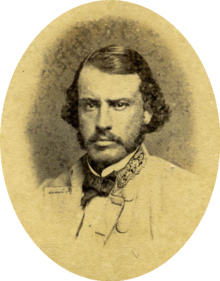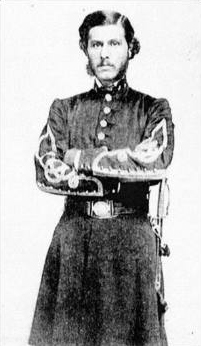
Brigadier General Frank Crawford Armstrong
Many soldiers fought for both sides during the war, but you hardly ever think of a general officer as having done so. You'd be wrong. Frank Crawford Armstrong was born in 1835 in Choctaw Territory in what is today known as Oklahoma. His father Francis W. Armstrong was an American army officer posted there at the time. Unfortunately, Frank would not remember his father because he died three months before Frank's birth. Frank's widowed mother soon married Mexican War General Persifor F. Smith. At age 19, Frank accompanied his step-father into New Mexico to fight Native Americans. His performance there earned him a commission in the United States Army as a lieutenant without him having to attend West Point.
After this campaign into New Mexico, Armstrong attended Holy Cross College and got his degree. He retained his commission in the army and served under Albert Sidney Johnston during the Mormon Campaign in what was labeled the Utah War. When the Civil War began, Armstrong was made a captain in the Federal Army and led a company of cavalry at the Battle of Manassas. On August 10th, just two weeks after the embarrassing Federal defeat at that battle, Armstrong resigned his commission and joined the Confederate Army. He served on both the staffs of Ben McCulloch and James M. McIntosh, both generals being killed at Pea Ridge. Armstrong was actually just feet from his commander Ben McCulloch when that officer was killed. He was then commissioned colonel of a Louisiana regiment before taking command of Sterling Price's cavalry. He soon received a promotion to brigadier general.
At the Battle of Chickamauga, Armstrong served under Nathan Bedford Forrest. He was soon given a brigade of Mississippi cavalry under Stephen D. Lee and served in Mississippi before joining the Army of Tennessee during the Atlanta Campaign. He served under Forrest during Hood's invasion of Tennessee and helped Forrest cover the retreat of the army into Alabama. He was captured fighting under Forrest in defense of Selma, Alabama. His military career was over.
Following the war, he served in the mail service in Texas, became an Indian inspector, and eventually became Assistant Commissioner of Indian Affairs. He died in Bar Harbor, Maine in 1909 at his daughter's house. I actually wrote to the local city historian in Bar Harbor a few years ago and asked her about the address where Armstrong died. She knew of the address, but almost called me a liar when I stated a Confederate general died in her town. Having resigned his U.S. Army commission on August 10, 1861 and joining the Confederate Army, his resignation wasn't accepted until August 13th. This means that Frank Crawford Armstrong served three days in both armies during the war. Frank Armstrong was 73 years old when he died and rests today in Rock Creek Cemetery, Washington, D.C.

Another wartime image of Frank Crawford. (He is ranked colonel in this image).




















